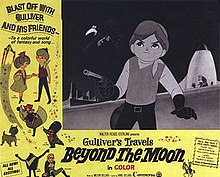Gulliver's Travels Beyond the Moon
| Gulliver's Travels Beyond the Moon | |
|---|---|
 Theatrical poster to the 1965 US release of Gullivers Travels Beyond the Moon | |
| Directed by | Masao Kuroda Sanae Yamamoto |
| Written by | Shinichi Sekizawa Jonathan Swift (novel Gulliver's Travels) Hayao Miyazaki (additional screenplay material; uncredited) |
| Produced by | Hiroshi Okawa Akira Onozaki |
| Starring | voices: Herb Duncan (US) Robert Harter (US) Darla Hood (US) Chiyoko Honma (Japan) Masao Imanishi (Japan) Seiji Miyaguchi (Japan) Akira Oizumi (Japan) Shoichi Ozawa (Japan) Kyū Sakamoto |
| Music by | Isao Tomita (Japanese version) Anne DeLugg (US version) Milton DeLugg (US version) |
| Distributed by | Toei Co. Ltd. (Japan) Continental Distributing Inc. (1966 US) |
Release dates | March 20, 1965 (Japan) July 23, 1966 (US) |
Running time | 80 min. 85 min. (US |
| Language | English |
Gulliver's Travels Beyond the Moon (ガリバーの宇宙旅行, Garibā no Uchū Ryokō, Gulliver's Space Travels) (also known as Space Gulliver) is a 1965 Japanese animated feature which was released in the United States in 1966.
Production
This was one of the first Toei animated features to depart from Asian mythology, though, like Toei's previous animated features, it is modeled after the Disney formula of animated musical feature. By borrowing elements from Hans Christian Andersen, Jonathan Swift and science-fiction, it was hoped that this film would attract a large international audience. However it proved to be no more popular than Toei's previous, Asian-themed films. After the failure in the U.S. of this, and Toei's previous animated featured, this was the last Japanese animated feature to be released in the United States in over a decade, until Sanrio's Metamorphoses and The Mouse and His Child, both of which were released in the U.S. in 1978. [1]
Staff
Not yet the internationally popular electronic music composer he was later to become, Isao Tomita contributed the original Japanese score. However, for the American edition, songs were composed by Milton and Anne Delugg, who had provided the song "Hooray for Santy Claus" for Santa Claus Conquers the Martians (1964).
In one of his earliest animation jobs, a young Hayao Miyazaki worked on this film as an in-between artist. His contribution to the ending of the film brought Miyazaki to the attention of Toei. The screenplay was written by Shinichi Sekizawa, the writer of the first Mothra (1961). Sekizawa also contributed screenplays to some of the most popular films in the Godzilla series from King Kong vs. Godzilla (1962), to Godzilla vs. Mechagodzilla (1974), including Mothra vs. Godzilla (1964).
Plot
The story concerns a homeless boy named Ricky, or Ted in the Japanese version. After seeing a movie about Gulliver he meets Professor Gulliver himself in a forest. Gulliver is now an elderly, space-traveling scientist. With Dr. Gulliver's assistant Sylvester the crow (named Crow in the Japanese edition), and Ricky's companions, a talking dog and a toy soldier, they travel the Milky Way to the Planet of Blue Hope, which has been taken over by the Queen of Purple Planet and her evil group of robots. Armed with water-pistols and water balloons, which melt the villains, Ricky and Gulliver restore Blue Hope to its doll-like owners.
Home video
Though the film was released on DVD by BCI Eclipse on February 22, 2005, it is currently out of print, and not available on home video.
Notes
- ^ *Beck, Jerry (2005). The animated movie guide. Chicago: Chicago Review Press. ISBN 1-55652-591-5., p.101
External links
References
- Beck, Jerry (2005). The animated movie guide. Chicago: Chicago Review Press. ISBN 1-55652-591-5.
- Clements, Jonathan and Helen McCarthy (2001). The anime encyclopedia : a guide to Japanese animation since 1917. Berkeley, Calif: Stone Bridge Press. ISBN 1-880656-64-7.
